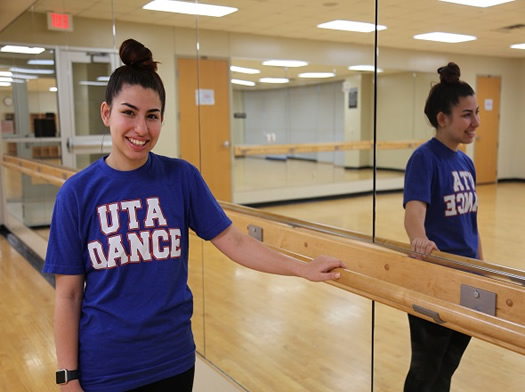Alyssa Rodriguez has been dancing most of her life. Some of her fondest childhood memories were inside a dance studio. She had her first major injury at the age of 13 with a torn meniscus. "I was still dancing, walking and doing everything but I didn't know it was torn," Rodriguez said.
A torn meniscus is a common knee injury in any physical activity. Dancers often experience this type of injury if they forcefully twist or rotate the knee while putting their full body weight on the knee. It can cause pain, swelling and stiffness. In some cases, it can require surgical repair.

Now as a junior on the UT Arlington Mavericks Dance Team, she practices with her squad four to five days a week, performs at games and various community events. A Texas Health Sports Medicine lead athletic trainer, Morgan Tharp, watches the dancers' every move. Tharp not only helps reduce the frequency and severity of injuries — she feels like she's part of the team.
"Dancers are predisposed to many different injuries to the knee, ankle and hips," Tharp said. She's also the primary athletic trainer for the cheer team. Besides UTA, Texas Health Sports Medicine athletic trainers work with student athletes at universities across North Texas.
Latest injury
In July 2018, Rodriguez was practicing with her squad in preparation for the National Dance Alliance camp. "We were doing twists and turns to the ground and practicing kip-ups, where you roll back, throw your body forward and land on your feet," Rodriguez said. After practice, her left knee started bothering her. She thought it would get better after some rest.
"The next day I was dancing and after the third time of twisting to the ground, I couldn't do it anymore. It hurt that bad. I knew something was wrong," Rodriguez said. She couldn't bend her knee all the way or keep it straight. She says it even hurt to do a squat.
Luckily, Tharp was there when it happened. "With her previous history of injury and the mechanism of the new injury, I suspected it might be her meniscus again," Tharp said. "I used a HOPS (History, Observation, Palpation and Special Tests) evaluation to determine our next step." Tharp called Texas Health to set up an appointment with an orthopedic physician and suggested she get an MRI.
"I've never wanted to cry that bad with a knee injury," Rodriguez said. "I was upset and frustrated that I was hurt again. It took a lot of work to get my knee back to where it was."
After talking it over with her mom, Rodriguez decided to get a meniscectomy, a surgery to remove part of the lateral meniscus on her left knee, because of the persistent discomfort.
The recovery
She was able to put weight on her knee three days after surgery and start physical therapy. "The recovery can last up to 12 weeks if there's no complications from surgery," said Adam Culiver, P.T., D.P.T., S.C.S., a physical therapist with Texas Health Sports Medicine.
"Getting mobility back into my leg was my biggest challenge," Rodriguez said. "But Adam made me feel comfortable about the exercises and motivated me to keep going."
Culiver says everyone's treatment is different. "Don't base your progress off someone else's," he said. "I tell my patients there's a difference between good soreness and bad soreness. We'll come back to a workout once they feel more comfortable."
For nearly three months, Rodriguez watched her squad practice and perform as she sat on the sidelines. She says she's very grateful for their understanding of her injury. "They understood that I wanted to dance — I was just physically unable to do so," she said.
Rodriguez is fully recovered and working with her team to learn a new routine for the National Dance Alliance Championship in Dayton Beach, Florida. Rodriguez says she's looking forward to representing UTA at the competition in April.
"I have to be more cautious since my surgery, so I don't injure myself again," Rodriguez said. "But I'm ready to compete and be there for my team."
Related News
About Texas Health Resources
Texas Health Resources is a faith-based, nonprofit health system that cares for more patients in North Texas than any other provider. With a service area that consists of 16 counties and more than 8 million people, the system is committed to providing quality, coordinated care through its Texas Health Physicians Group and 29 hospital locations under the banners of Texas Health Presbyterian, Texas Health Arlington Memorial, Texas Health Harris Methodist and Texas Health Huguley. Texas Health access points and services, ranging from acute-care hospitals and trauma centers to outpatient facilities and home health and preventive services, provide the full continuum of care for all stages of life. The system has more than 4,400 licensed hospital beds, 6,400 physicians with active staff privileges and nearly 29,000 employees. For more information about Texas Health, call 1-877-THR-WELL, or visit www.TexasHealth.org.
